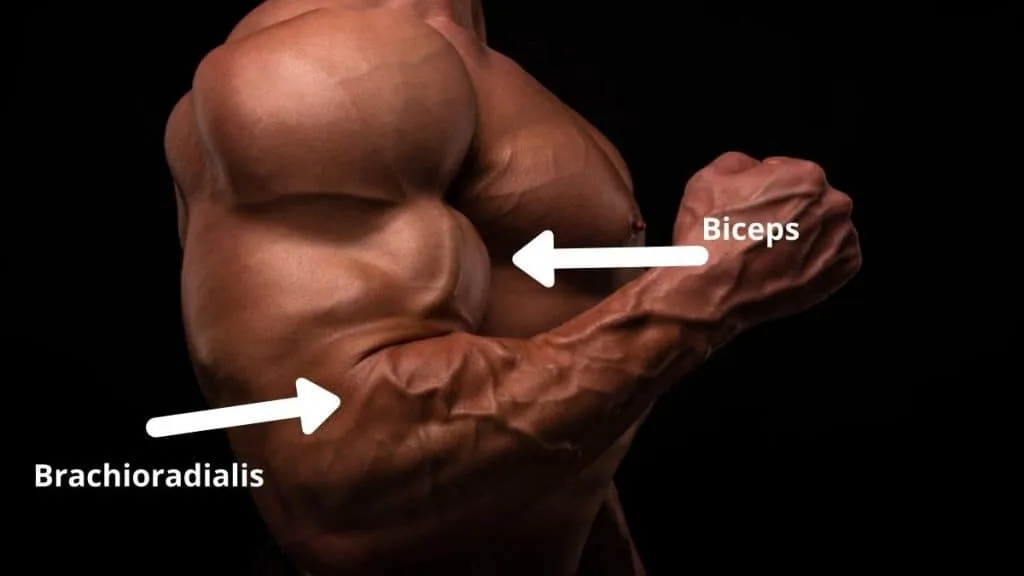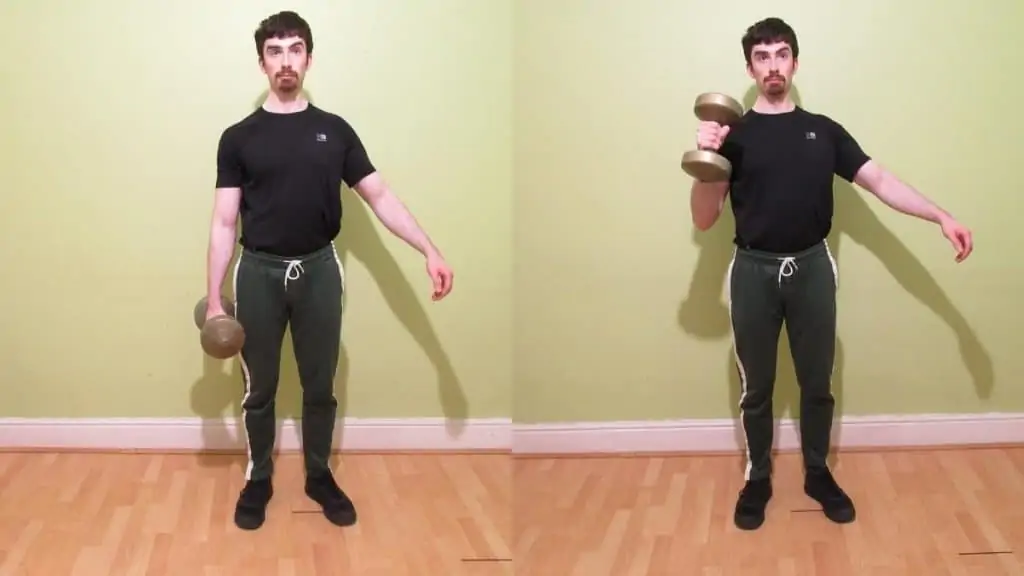Single arm hammer curls are a great exercise for isolating the biceps muscles because they really let you hone in on each arm to give it the best possible workout.
This guide explains how to do hammer curls one arm at a time, as well as the advantages and disadvantages of performing the exercise for muscle growth.
One arm hammer curl exercise details
- Main Muscles: Biceps brachii, brachialis, brachioradialis
- Secondary Muscles: Forearm extensors, forearm flexors
- Exercise Type: Strength
- Exercise Mechanics: Isolation
- Difficulty Level: Beginner
- Equipment Needed: Dumbbell
How to perform single arm hammer curls
- Grab a dumbbell with a neutral grip.
- Stand up straight and hold the dumbbell by your side.
- Curl the weight toward your shoulder.
- Keep lifting until your biceps and forearm make forceful contact.
- Squeeze your arms at the top of the rep.
- Lower the dumbbell under control until your elbow is fully extended.
- Repeat the motion for your other arm and do 3-4 sets of 8-12 reps per arm.
One arm hammer curl advantages
The one arm hammer curl is rarely performed because most people prefer to save time by training both arms together. And while I can certainly understand their desire for convenience, these lifters, as you’ll soon learn, are missing out by overlooking the single arm hammer curl.
Improved bicep and brachioradialis isolation

When you only have to lift one weight as opposed to two, you can channel all of your energy, focus, and strength into training one set of arm muscles.
As a result, you’ll naturally have a better mind-muscle connection when doing the single hammer curl because you’ll no longer need to divide your body’s resources over two arms. Instead, you can put every ounce of effort into stretching and squeezing the target muscles rather than just lifting weights from point A to point B.
Moreover, because you’re only training one arm at a time, you’ll likely also find that you’re stronger on single hammer curls for the reasons specified above—you can direct all of your force output to one particular arm rather than having to distribute it over two. [1]
To really take your biceps out of the movement, you can do one arm reverse curls instead to keep even more tension on your brachioradialis and brachialis.
Fewer muscle imbalances

Another reason why unilateral exercises in general, and single-arm dumbbell hammer curls in particular, are effective is that they can limit your muscle imbalances and help to improve existing ones.
With single arm hammer curls, you can ensure that each arm is getting the same amount of attention, which isn’t always possible when you have to focus on lifting two dumbbells. The end result is more proportional arm muscles and, as a result, a more symmetrical and aesthetic physique.
One arm hammer curl disadvantages
I won’t sugarcoat it. As good as the single dumbbell hammer curl is, there are two main downsides that might put you off performing it if you have poor core strength or an extremely busy lifestyle.
Takes longer to perform

Single arm hammer curls take roughly twice as long to perform as lying hammer curls and the regular two-arm version. Therefore, if you have a hectic schedule and can only spare a short amount of time for a workout, then you’re probably best of sticking with regular hammer curls.
This might not seem like a big deal if you love lifting weights, but if you start doing multiple exercises one arm at a time, then your training session can really begin to drag and feel more like a cruel punishment than a fun workout.
This is also the case for other unilateral exercises like one-arm dumbbell spider curls, which primarily work your biceps.
You might feel off balance

When you’re curling a heavy dumbbell one arm at a time, you can often feel off balance because the weight is essentially trying to topple your torso over to one side. As such, you’ll need good core strength to do single hammer curls properly.
You can remedy this problem by holding onto a bench as you perform the exercise. This way, you can still enjoy the increased muscle isolation mentioned above, but without the lack of balance that could actually impair your focus and thus your bicep stimulation.
If you do the one leg hammer curl, then you’ll likely also experience this problem. However, since that particular exercise is supposed to make you feel off-balance, it’s not actually a big deal because the extra core strength that you’ll gain will be worth the marginally lower bicep and brachioradialis stimulation.
Should you do single arm hammer curls for your biceps?

Single arm hammer curls are a straightforward exercise that’s great for beginners and advanced lifters alike. The movement can help you to build a more proportional upper body by ensuring that both of your arms receive equal work. [2]
It’s recommended to stick to moderate reps for the one arm hammer curl because both the biceps and brachioradialis are predominantly fast-twitch in their muscle fiber composition.
Other than that, just make sure to use a full range of motion wherever possible. This way, you’ll stimulate the maximum amount of muscle fibers, and you won’t get tempted to lift excessively heavy dumbbells.
References
- Škarabot, J., Cronin, N., Strojnik, V., & Avela, J. (2016). Bilateral deficit in maximal force production. European Journal of Applied Physiology, 116(11–12), 2057–2084. https://doi.org/10.1007/s00421-016-3458-z
- Gonzalo-Skok, O., Tous-Fajardo, J., Suarez-Arrones, L., Arjol-Serrano, J. L., Casajús, J. A., & Mendez-Villanueva, A. (2017). Single-Leg Power Output and Between-Limbs Imbalances in Team-Sport Players: Unilateral Versus Bilateral Combined Resistance Training. International Journal of Sports Physiology and Performance, 12(1), 106–114. https://doi.org/10.1123/ijspp.2015-0743

